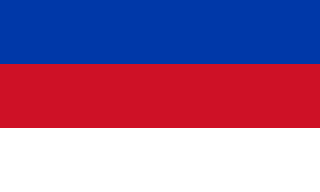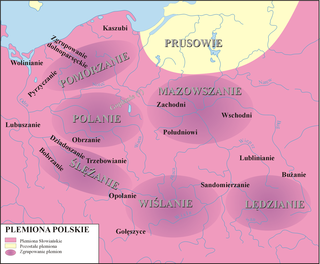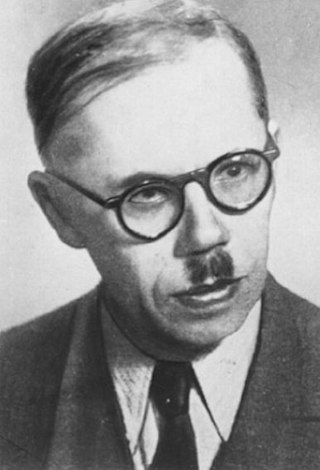Related Research Articles

Sorbs are an indigenous West Slavic ethnic group predominantly inhabiting the parts of Lusatia located in the German states of Saxony and Brandenburg. Sorbs traditionally speak the Sorbian languages, which are closely related to Czech, Polish, Kashubian, Silesian, and Slovak. Upper Sorbian and Lower Sorbian are officially recognized minority languages in Germany.

The Severians, also Severyans, Siverians, or Siverianians were a tribe or tribal confederation of early East Slavs occupying areas to the east of the middle Dnieper River and southeast of the Danube River. They are mentioned by the Bavarian Geographer, Emperor Constantine VII (956–959), the Khazar ruler Joseph, and in the Primary Chronicle (1113).
The epithet "Bavarian Geographer" is the conventional name for the anonymous author of a short Latin medieval text containing a list of the tribes in Central-Eastern Europe, headed Descriptio civitatum et regionum ad septentrionalem plagam Danubii.

Svarog is a Slavic god of fire and blacksmithing, who was once interpreted as a sky god on the basis of an etymology rejected by modern scholarship. He is mentioned in only one source, the Primary Chronicle, which is problematic in interpretation. He is presented there as the Slavic equivalent of the Greek god Hephaestus. The meaning of his name is associated with fire. He is the father of Dazhbog and Svarozhits.

The Drevlians or Derevlianians were a tribe of Early East Slavs between the 6th and the 10th centuries, which inhabited the territories of Polesia and right-bank Ukraine, west of the eastern Polans and along the lower reaches of the rivers Teteriv, Uzh, Ubort, and Stsviha. To the west, the Drevlians' territories reached the Sluch River, where the Volynians and Buzhans lived. To the north, the Drevlians' neighbors were the Dregovichs.
The Buzhans were one of the tribal unions of Early Slavs, which supposedly formed East Slavs in Southern Russia and Volga region. They are mentioned as Buzhane in the Primary Chronicle. Several localities in Russia are claimed to be connected to the Buzhans, like for example Sredniy Buzhan in the Orenburg Oblast, Buzan and the Buzan river in the Astrakhan Oblast.
The Serbs trace their history to the 6th and 7th-century Balkan migration of the Early Slavs. These migrants absorbed the local Byzantines, mostly descendants of different paleo-Balkan peoples, but also of other former Roman citizens, and later established various states throughout the Middle Ages.

The Vistulans, or Vistulanians, were an early medieval Lechitic tribe inhabiting the western part of modern Lesser Poland.

Radogost is, according to medieval chroniclers, the god of the Polabian Slavs, whose temple was located in Rethra. In modern scientific literature, however, the dominant view is that Radogost is a local nickname or a local alternative name of the solar god Svarozhits, who, according to earlier sources, was the chief god of Rethra. Some researchers also believe that the name of the town, where Svarozhits was the main deity, was mistakenly taken for a theonym. A popular local legend in the Czech Republic is related to Radogost.

The White Croats, also known simply as Croats, were a group of Early Slavic tribes that lived among other West and East Slavic tribes in the historical region of Galicia north of the Carpathian Mountains, in modern western Ukraine, Lesser Poland, Eastern Slovakia, and Northeastern Bohemia.
Podaga is a Polabian deity who had his statue in a temple in Plön. Mentioned only in Helmold's Chronicle, which does not give a depiction or function of the deity.
Among the Slavs there are many modes of idolatry and not all of them coincide with the same kind of superstition. Some create in their temples statues of fantastic forms, such as the idol of Plön, who is called Podaga, others live in forests and groves, as is the case of the god Prone of Oldenburg, of whom no image exists.

The West Slavs are Slavic peoples who speak the West Slavic languages. They separated from the common Slavic group around the 7th century, and established independent polities in Central Europe by the 8th to 9th centuries. The West Slavic languages diversified into their historically attested forms over the 10th to 14th centuries.

The Lendians were a Lechitic tribe who lived in the area of East Lesser Poland and Cherven Cities between the 7th and 11th centuries. Since they were documented primarily by foreign authors whose knowledge of Central and East Europe geography was often vague, they were recorded by different names, which include Lendzanenoi, Lendzaninoi, Lz’njn, Lachy, Lyakhs, Landzaneh, Lendizi, Licicaviki and Litziki.

Henryk Łowmiański was a Polish historian and academic who was an authority on the early history of the Slavic and Baltic people. A researcher of the ancient history of Poland, Lithuania and the Slavs in general, Łowmiański was the author of many works, including most prominently the six-volume monumental monograph Początki Polski.

The Serboi was a tribe mentioned in Greco-Roman geography as living in the North Caucasus, believed by scholars to have been Sarmatian.

The Sorbs, also known as White Serbs in Serbian historiography, were an Early Slavic tribe settled between Saale-Elbe valley up to Lusatian Neisse, and part of the Wends. In the 7th century, the tribe joined Samo's Empire and part of them emigrated from their homeland White Serbia to the Balkans. The tribe is last mentioned in the late 10th century, but its descendants are an ethnic group of Sorbs and Serbs.
Praedenecenti was an early medieval Slavic tribe, mentioned only in the Royal Frankish Annals in 822 and 824. They lived in the buffer zone between the Carolingian and Bulgarian empires. The Royal Frankish Annals associated them with the Abodriti, while modern scholars have also connected them to other Slavic tribes, especially the Braničevci or Merehani. The Praedenecenti sought assistance from the Franks against the Bulgars, but they obviously lost their independence because they were not mentioned after 824.
The Sebbirozi was a tribe mentioned by the 9th-century Bavarian Geographer (BG). It states that the Sebbirozi inhabit 90 settlements.
Znetalici was a Slavic tribe mentioned by the 9th-century Bavarian Geographer. They are mentioned as inhabiting 74 civitates (settlements).
References
- ↑ Curta, Florin (2019). Eastern Europe in the Middle Ages (500-1300) (2 Vols). Boston: BRILL. p. 44. ISBN 978-90-04-39519-0. OCLC 1111434007.
- 1 2 Šafařík 1865, p. 29.
- 1 2 Cross 1963, p. 6.
- 1 2 3 Koncha, S. (2012). "Bavarian Geographer On Slavic Tribes From Ukraine" (PDF). Ukrainian Studies. Bulletin of Taras Shevchenko National University of Kyiv. 12: 15–21.
- ↑ Zeuss 1837, p. 615.
- ↑ Lelewel 1852, p. 43.
- ↑ Persowski 1962, p. 73.
- ↑ Palacký 1876, p. 89.
- ↑ Lubor Niederle (1923). Manuel de l'antiquité slave ... É. Champion. p. 19.
- 1 2 Henryk Łowmiański, O identyfikacji nazw Geografa bawarskiego , Studia Źródłoznawcze, t. III: 1958, s. 1–22; reed: w: Studia nad dziejami Słowiańszczyzny, Polski i Rusi w wiekach średnich, Wydawnictwo Naukowe Uniwersytetu im. Adama Mickiewicza, Poznań 1986, s. 151–181, ISSN 0554-8217
- ↑ Witczak 2013, p. 34, 37–43.
- ↑ Łuczyński, Michal (2017). ""Geograf Bawarski" — nowe odczytania" ["Bavarian Geographer" — New readings]. Polonica (in Polish). XXXVII (37): 77–78. doi:10.17651/POLON.37.9 . Retrieved 4 August 2020.
- ↑ Ляска, В. (2014). "Між Прагою, Києвом та Ґнєзно. Zeriuane/zuireani "географа баварського": до проблеми етнопотестарних структур Волині у ранньому Середньовіччі" [Between Prague, Kyiv and Gniezno. Zeriuane/zuireani of Bavarian geographer: the question of ethnic prestate structures in Volhynia in the early middle ages]. Княжа доба: історія і культура (in Ukrainian) (8): 9–71. doi:10.17651/POLON.37.9 . Retrieved 4 August 2020.